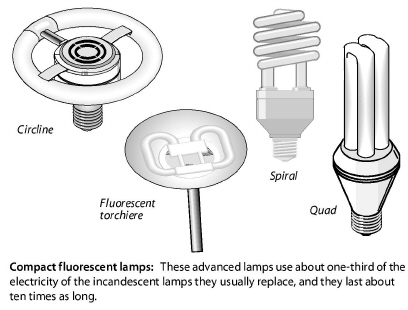
10.3 Lighting-Efficiency Improvements
Lighting-efficiency improvements include bulb (lamp) replacement, daylighting, fixture replacement, and energy-efficient lighting controls.
Use daylighting as appropriate to save electricity.
ü Replace, adjust, or repair window coverings to maximize useful daylight where appropriate.
ü Design and use active and passive day lighting where appropriate.
10.3.2 Lighting Retrofit Equipment
Consider The following requirements when retrofitting lighting equipment.
ü Ask the customer about their lighting usage, and explain the electrical savings potential for switching to compact fluorescent lamps (CFLs) or light-emitting diodes (LEDs).
ü Demonstrate a CFL or LED bulb to the customer if they’re hesitant about replacing their incandescent light bulbs.
ü Select the type of CFL or LED and its wattage, according to its use and the customer’s accustomed light level.
ü Turn on each CFL or LED after installation to ensure that it operates. Make sure that the customer is satisfied with the light level.
ü Replace halogen torchieres with fluorescent torchieres.
ü All bulbs, fixtures, and controls must be appropriate for the intended application (for example: enclosed, dimmable, indoor, outdoor).
ü Select bulbs, fixtures, and controls to provide the brightness and light quality required in that application (for example: task lighting, walkway lighting, night lights).
ü Selected equipment should have the highest level of efficiency within a technology, such as bulbs, fixtures, or controls.
ü All bulbs, fixtures, and controls must be Energy Star® rated where applicable.
ü When possible, select bulbs, fixtures, and controls that employ the latest energy-efficient lighting technology.
ü Bulb wattage must not exceed rated wattage of the light fixture.
ü Select bulb replacements based on expected life span, light quality, and lifetime energy use.
ü Install occupancy sensing controls where appropriate.
ü All bulbs, fixtures, and controls will be UL-approved and installed according to local code(s) and NFPA 70 National Electric Code
ü Inform customers about proper recycling of fluorescent bulbs by stores, municipal waste departments, or other recycling organizations.
ü Replace fluorescent light ballasts containing polychlorinated biphenyls (PCBs) according to the EPA’s Healthy Indoor Environment Protocols for Home Energy Upgrades.
